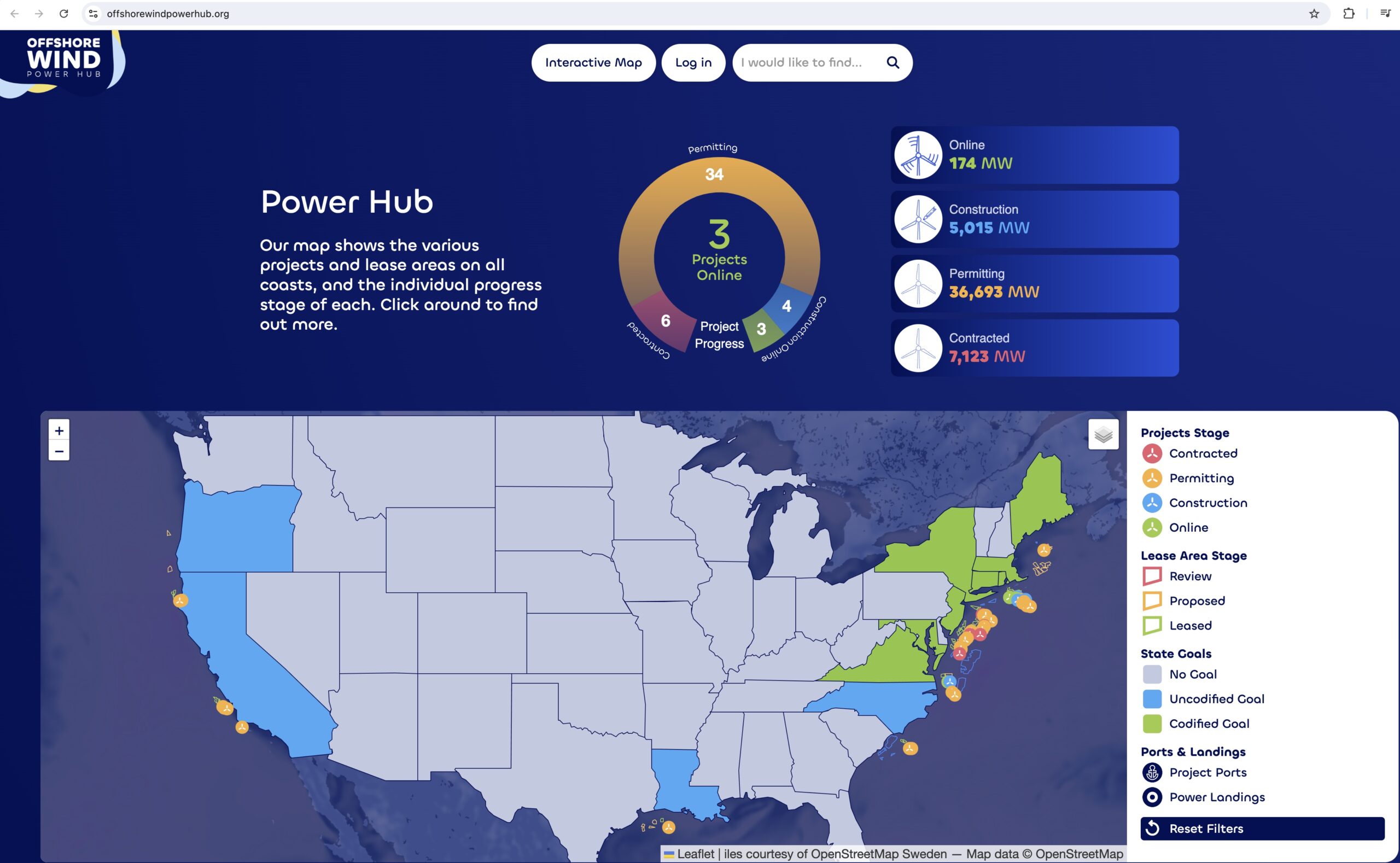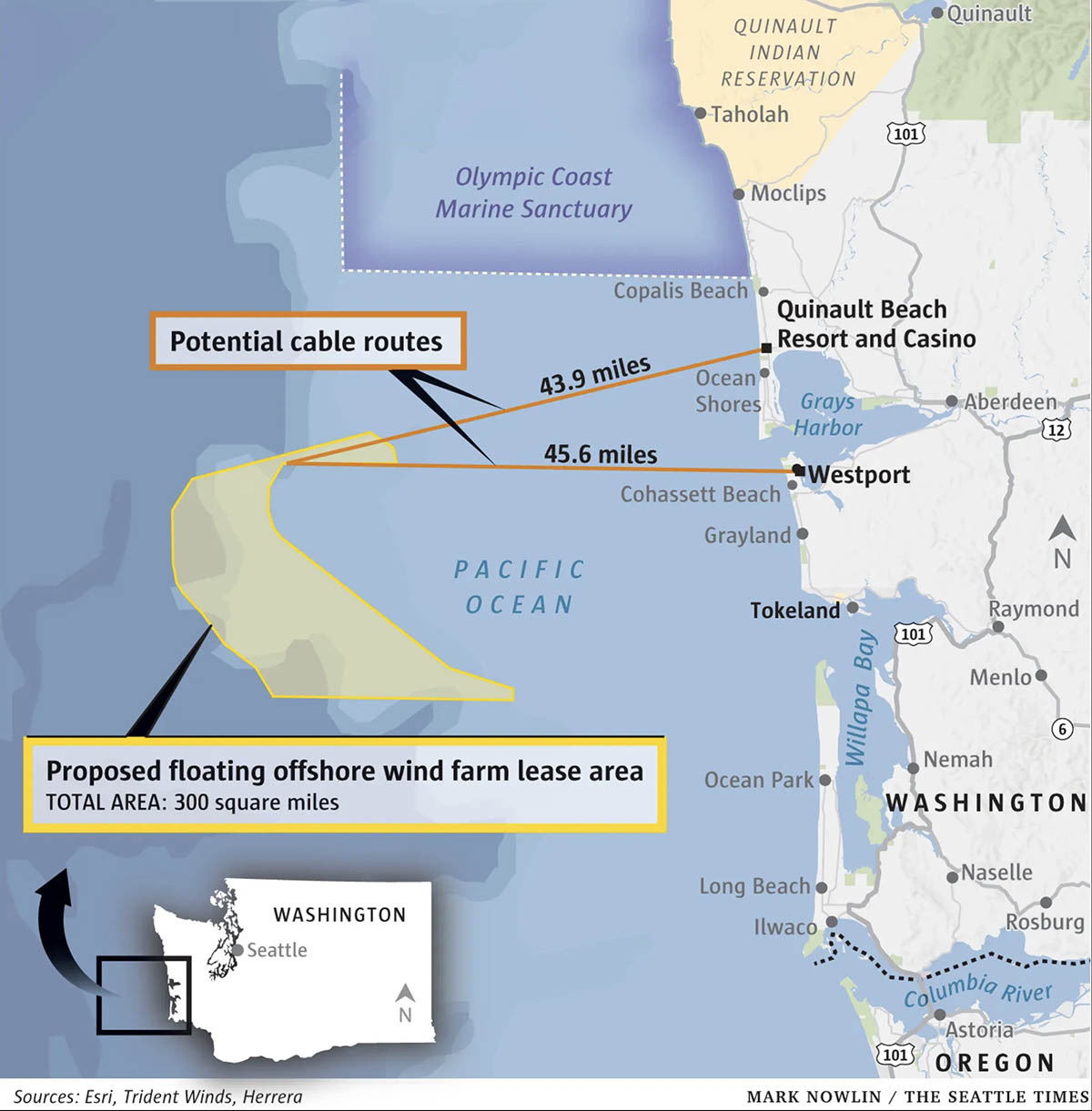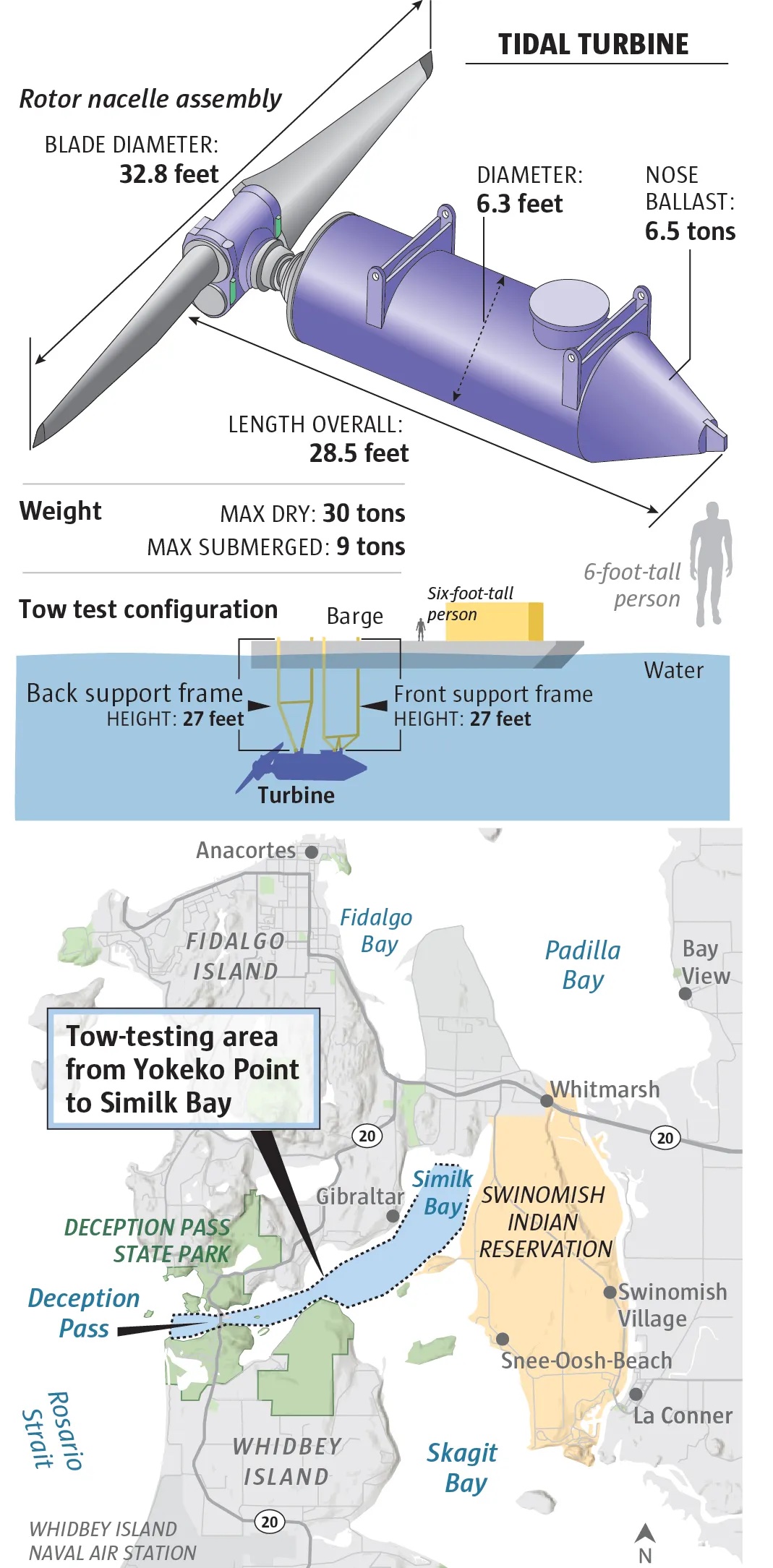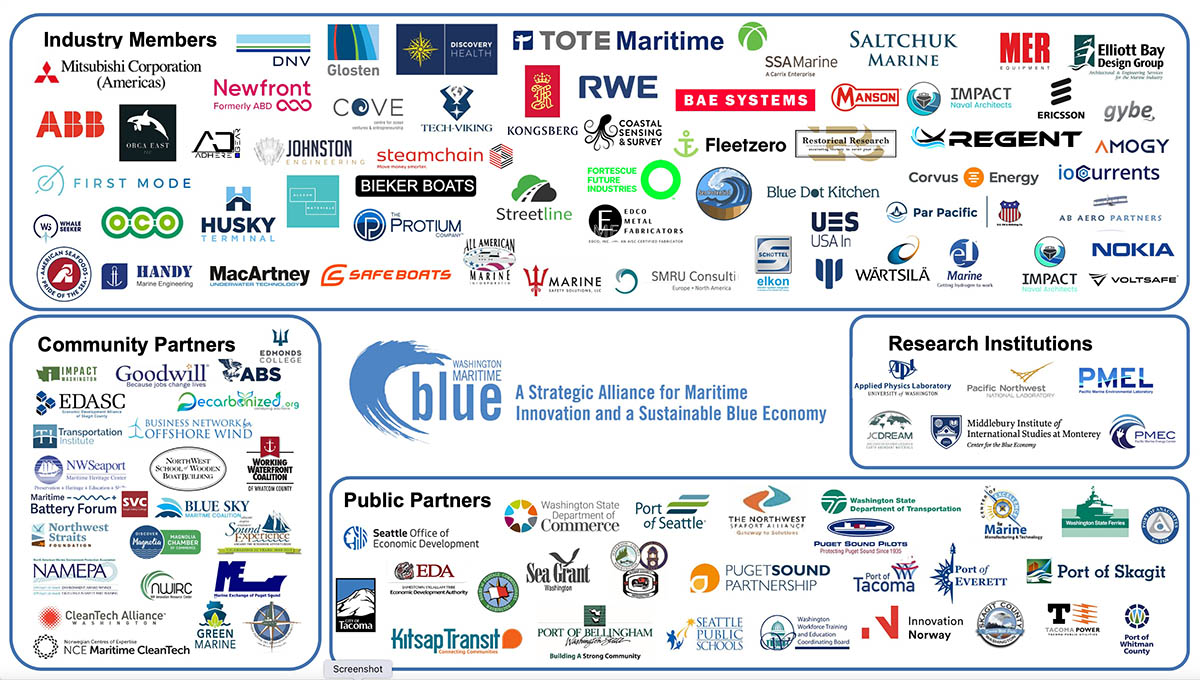Offshore energy projects in the PNW

Power Hub
A website has been launched to track offshore energy projects. With this website you can find out the status of an offshore project (contracted, permitting, construction, online) and find the names of the developers, projected output, and more.
Website:

206 Square Miles – Northern California
The offshore wind project off the coast of Northern California at Humboldt County will industrialize 206 square miles of ocean. The wind energy area is 28 miles north to south and 14 miles east to west in size, and 21 miles offshore Eureka, CA. The Humboldt Bay Port will be expanded. Typical offshore wind turbines are approximately 900-1000 feet tall (70-100 story building), with blade lengths of up to 350 feet (for a rotor diameter of 700 feet).
Two lease sites sold at a December 2022 auction for $331.5 million. The winning bidders were RWE Offshore Wind Holdings at $157.7 million for 63,338 acres and California North Floating, LLC at $173.8 million for 69,031 acres.
The RWE site is named Canopy. RWE also plans to open an office for its local team in Eureka in early 2024.
References:
- BOEM Final Environmental Assessment
- RWE Offshore Wind Holdings, LLC (OSC-P 0561)
- California North Floating LLC (OCS-P 0562)
- BOEM Humboldt Wind Energy Area main page
News:

1,811 Square Miles – Oregon
The two offshore wind projects off the coast of Oregon will industrialize 1,811 square miles of ocean. It is currently unknown how many turbines will be proposed for these projects. Typical offshore wind turbines are approximately 900-1000 feet tall (70-100 story building), with blade lengths of up to 350 feet (for a rotor diameter of 700 feet). These projects will be situated 13-57 miles off the cost of Southern Oregon. The Coos Bay area is about 50m north to south, and 35 east to west in size; the Brookings area is about 46m north to south and 22m east to west in size. The Coos Bay Port will be expanded between 65 to 210 acres to include a Staging and Integration facility, a Manufacturing and Fabrication Facility and an Operation and Maintenance facility.
The final environmental assessment is complete, and BOEM concluded, after a public comment period, that issuing leases in mid-October will have “no significant impacts to people or the environment,” despite rigorous pushback from communities and tribes in the state. This begins the leasing phase of these projects, which will trigger an environmental impact statement (EIS) process.
The lease sale for the two identified wind energy areas is scheduled for October 15, 2024, with five companies qualified to participate in the sale.
On September 13, 2024, the Confederated Tribes of the Coos, Lower Umpqua and Siuslaw Indians filed a lawsuit against the Bureau of Ocean Energy Management (BOEM) to stop the lease sale.
On September 27, 2024, BOEM announced that it is “delaying the offshore wind energy auction planned for potential lease areas offshore Oregon due to insufficient bidder interest at this time” when all but one of the companies that had planned to submit lease proposals for the wind energy areas pulled out.
References:

~400 Square Miles – Washington
Two companies have submitted unsolicited lease requests to BOEM to develop offshore wind projects near Westport, WA. Trident Winds and Hecate Energy have submitted these proposals. As of yet, BOEM has not put out a call for lease proposals in WA for floating offshore wind projects. These projects would be located approximately 45 miles offshore, west of Westport, WA.
WA State Department of Commerce commissioned Gridworks in December 2023 to develop recommendations to plan offshore wind energy development off Washington’s coast. Gridworks submitted their final report in June 2024. This report is a prime example of how government agencies pressure communities into accepting environmental destruction.
References:
- Unsolicited request for energy commercial lease by Trident Winds (for Olympic Wind floating offshore wind project)
- Letter from Washington Coastal Marine Advisory Council to Governor Inslee about unsolicited SEA proposals
- Trident Winds Olympic Wind Proposal
- Gridworks Report: An Offshore Wind Engagement Framework for Washington State



Rosario Strait Tidal Energy Project – Washington
Orcas Power and Light Cooperative (OPALCO) formed a strategic alliance with Orbital Marine Energy Ltd. in 2021, proposing to install one to four floating tidal turbines in Rosario Strait. Each machine would be 243 feet in length, and 194 feet wide, approximately the size of a Boeing 747. One machine would power up to only 400 homes. Massive mooring cables and anchors would hold the turbine machine in position.
Very few of these machines are in use worldwide, so the impacts on the marine environment are unknown. The large 98 foot diameter rotors, with a total swept area of 7,600 square feet, are likely to create disturbing noise, and potentially injure or kill diving birds, fish, and sea mammals. The cables holding the machines in place will likely scour the seabed (similar to other marine cables for offshore wind turbines and oil rigs) and create large sediment plumes that can kill marine life. Electrical cables bringing power onshore emit electromagnetic radiation that some marine animals are sensitive to and damage the seabed.
Increased marine traffic for installation and maintenance will increase noise and disturb marine environments. It is uknown if the machines leak oil during regular operation like wind turbines often do. It is unknown if offshore substations are required, which would have additional impacts on the marine environment.
OPALCO has applied for DoE funding for a phase 1 feasibility study. Permitting agencies include the Federal Energy Regulatory Commission (FERC), National Marine Fisheries Service, USFWS, Army Corps of Engineers, and various state agencies. On March 28, 2025, OPALCO submitted the Draft License Application to FERC.
Studies related to a tidal energy project in Admiralty Inlet near Whidbey Island showed that the tidal machine’s turbines could produce 180 decibels of sound in the critical habitat of endangered species, including orcas. The pain threshold for orcas is 135 decibels. The project was cancelled in 2014 after the federal government chose not to subsidize the project.
Latest News:
- Town hall events, January 21, 22, and 23, 2025 in San Juan County
- Preliminary FERC permit issued January 13, 2025 (PDF)
- Swinomish Tribe files letter with FERC complaining about non-responsiveness by OPALCO, February 26, 2025
- OPALCO files Draft License Application with FERC, March 28, 2025
- Swinomish Tribe files request for extension for more time to comment on OPALCO’s Draft License Application, April 3, 2025.
- Action Alert: Send your comments to FERC opposing tidal energy development in the Salish Sea by September 30, 2025
References:

Deception Pass Tidal Energy Project – Washington
California company Aquantis Energy planned to test a 2-bladed, 33-foot turbine designed to produce energy from tidal forces between Yokeko Point and Skagit Island. The first phase of the project did not require any state permits, nor a public comment period and was slated to begin in 2025. However, Washington State’s Commerce Department has pulled its $1.37 million grant, about 25% of the project’s funding. According to an article in the Seattle Times, “The path of the tow testing would have overlapped with a migratory path for spring Chinook salmon returning to the Skagit River.”
Latest News:
References:

Assessments and Leases – Alaska
A 2017 report quantifies Alaska’s offshore wind resource capacity. While the AK offshore wind energy potential is huge, as the report states, “significant challenges inhibit large-scale offshore wind deployment in Alaska” due to remoteness and other challenges. AK also has huge areas of onshore wind energy potential, so it is perhaps unlikely that offshore wind energy development will happen in AK’s waters anytime soon, but we’ll keep an eye on it.
Shell’s recent failed attempts over the past decade to drill for oil offshore AK illustrate the difficulty of offshore energy development in the region, although Shell still has oil and gas leases in the region.
Hilcorp Alaska LLC has several offshore energy development projects in the works, including a suspended project in the Beaufort Sea, in Foggy Island Bay, to build an artificial island and pipeline for oil and gas extraction, a lease for a Cook Inlet tidal energy project awarded in March of 2023, and an oil and gas lease also for Cook Inlet awarded in December, 2022.
Ocean Renewable Power Company, of Maine, is also looking at a tidal project in Cook Inlet. This company already has a river current energy generator on the Alaska Peninsula.
There is considerable concern that tidal energy turbines in Cook Inlet will harm salmon and beluga whale populations.
References:
- Offshore Wind Energy Resource Assessment for Alaska by the National Renewable Energy Laboratory
- Shell – Chukchi Sea Exploration Plan
- Shell – Beaufort Sea Exploration Plan
- Hilcorp to demo tidal tech from Cook Inlet platforms, January 2023
- Nikiski eyed for Cook Inlet tidal energy project, April 2021
- BOEM Statement on Cook Inlet Oil & Gas Lease Sale 258, December 2022
- BOEM Hilcorp Alaska LLC Liberty Prospect Project
- BOEM Cook Inlet OCS Oil & Gas Lease Sale 258, awarded to Hilcorp Alaska LLC (required per the Inflation Reduction Act)
- BOEM Oil and Gas – Alaska page

Unknown scope – Pacific Coast Wave Power
Oscilla Power is a Seattle-based startup that makes wave energy capture machines. They envision “deploying thousands of devices along the U. S. West Coast” in a giant array. Each machine in the array of thousands will be capable of generating 1 megawatt of power.
PacWave is based at Oregon State University and has two open ocean wave energy testing sites off the Oregon coast near Newport, OR.
References:

Industry Collaboratives and Supply Chains
Maritime Blue Wind Collaborative is an offshore wind industry and supply chain group working in collaboration with Washington State government that aims to build offshore wind manufacturing industries and workforce supply in WA.
References:
- Collaborative website
- Press release from Governor Inslee’s office at the official launch of the Supply Chain Collaborative, October 11, 2023
- Maritime Blue Wind Collaborative announces new leadership committee to guide Washington State’s offshore wind supply chain strategy in the American Journal of Transporation
